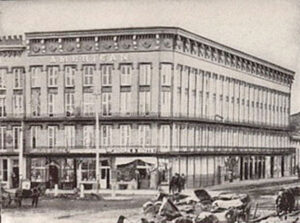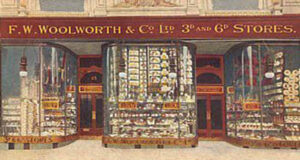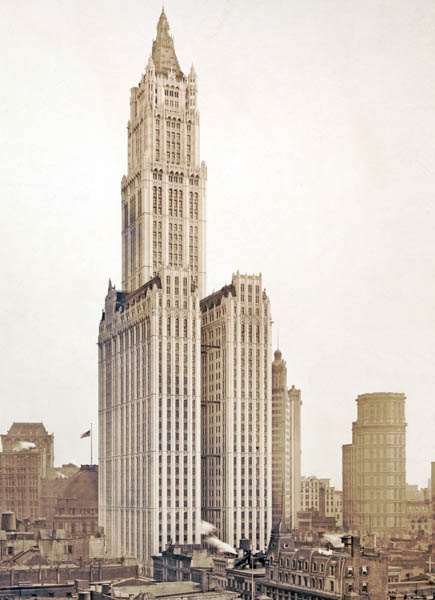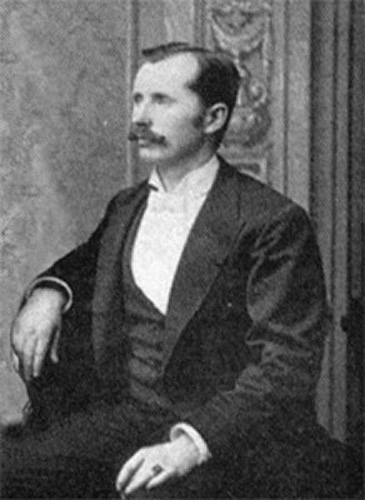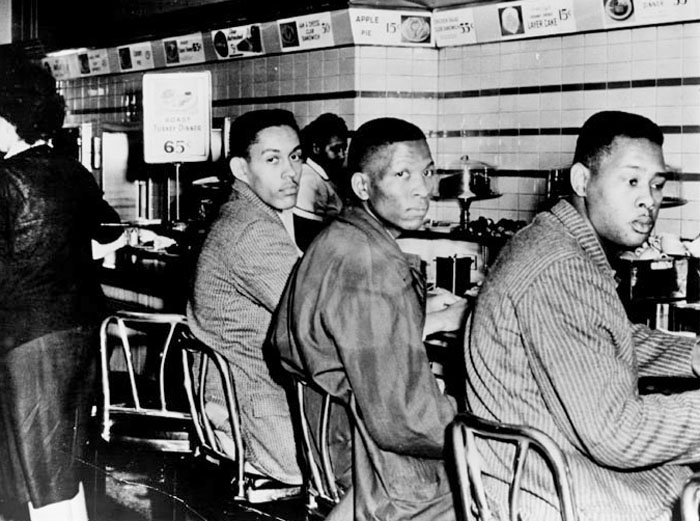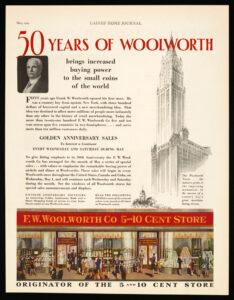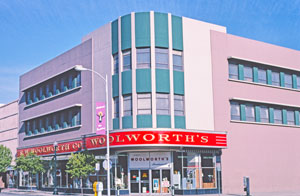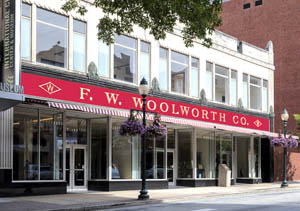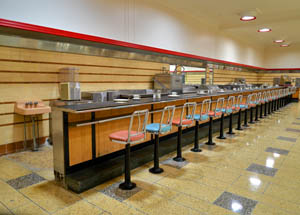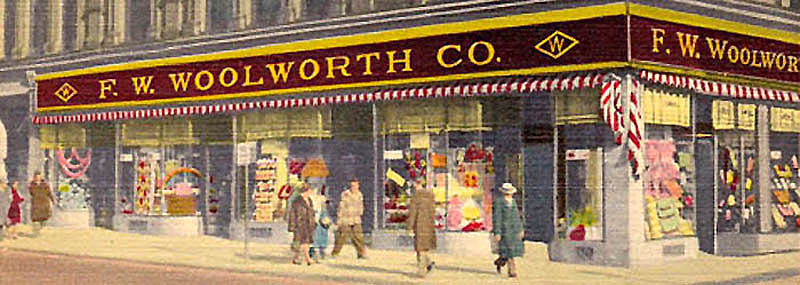
Woolworth Store in Boston, Massachusetts.
The Woolworth Company, the pioneer of “five-and-dime” stores worldwide, started in 1879 and, for more than 100 years, would remain a mainstay for value shoppers and diners in thousands of buildings.
The company was founded by Frank Winfield Woolworth, born in Rodman, New York, on April 13, 1852. At the age of 15, he gave up life on his father’s farm to seek his fortune working in a shop in Watertown. At the age of 21, he went to work as an unpaid apprentice for Augsbury & Moore’s Drygoods Store in Watertown, New York, in March 1873.
During this time, stores carried a wide variety of items that were serviced, meaning that most items were behind the counter, and an employee had to retrieve each item on a customer’s list. With Frank’s upbringing on a farm, he did not initially do well in this fine store, as he lacked social graces and was nervous and awkward with customers. William Moore then reassigned him to other duties that didn’t involve customers. Frank then began to clean the windows, stock shelves, clean the stockroom, and set up displays, to which he showed a natural flair. He soon took charge of display and stock management. One of his jobs was to set up a table of fixed-price five-cent goods — merchandise that usually didn’t sell well, such as baby bibs, trinkets, and sewing thimbles. It was a massive success as customers couldn’t resist the bargains.
In February 1879, Frank, with the blessing and a loan from his former boss William Moore, established a five-cent store in Utica, New York, with $321 worth of 5-cent goods. The store was called Woolworth’s Great Five Cent Store. Though the establishment was initially successful, the store soon failed in May 1879 after Frank earned enough money to pay back William Moore.
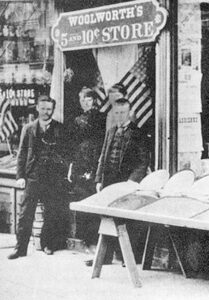
Woolworth 5 and 10 Cent Store in Lancaster, Pennsylvania.
However, Woolworth was determined and opened another store in Lancaster, Pennsylvania, with the same sign, in June 1879. The second store became very successful, especially after raising the price ceiling to 10 cents. This was one of the first stores to put merchandise in front of the customer rather than relying on a store clerk.
When Frank wanted to open another store in Harrisburg, Pennsylvania, he asked his brother Charles Sumner Woolworth to join him by managing it. The Harrisburg store opened as the “5¢ Woolworth Bro’s Store” on July 19, 1879.
In 1880, Woolworth first sold manufactured Christmas tree ornaments, which proved extremely popular.
After difficulties with the landlord, the Harrisburg store moved to York, Pennsylvania, in March 1880. However, it closed just three months later. Frank then searched for a larger, low-rent building and found an ideal location in Scranton, Pennsylvania, where he opened the “5¢ & 10¢ Woolworth Bro’s Store” on November 6, 1880, with his brother as manager. Charles Woolworth fully developed the store’s merchandising mode, spending a lot of time working on the sales floor and talking with customers and employees. By 1881, the store had become successful enough that Charles bought out Frank’s share of the Scranton store, making him the first Woolworth Bro’s franchisee.
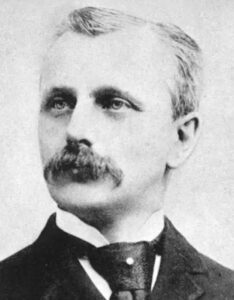
Frank Woolworth
In these early years, Woolworth founded its success on volume buying, discounted general merchandise, counter-display merchandising, excellent customer service, and cash-and-carry transactions. His stores were the first in the United States to put merchandise out for the shopping public to handle and select without the assistance of a sales clerk. Many of his new ideas for retailing set trends and created the modern retail model that stores continue to follow today.
In 1884, F.W. Woolworth started persuading his friends and family to open their own stores, all looking the same and operating under the founder’s name. All the merchandise came from Frank Woolworth, encouraging all the stores to maximize their inventory.
In the next decade, Frank Woolworth went on to open 21 more stores in towns in Pennsylvania, New Jersey, New York, Delaware, and Connecticut. The majority of these new stores were financed and managed as partnerships.
Over the next 20 years, Frank invited relatives and co-workers to join him, establishing a syndicate of five “friendly rivals.” The chains operated independently but carried his goods. The formula proved popular, allowing each partner to expand rapidly.
While Frank was expanding with more stores, his brother Charles’ approach was perfecting the look and feel of his Scranton store. The brightly lit store had mahogany counters with glass dividers and glass-fronted showcases and a wooden floor that was polished to a lustrous shine. Frank soon adopted the layout for his F. W. Woolworth stores, which became the standard as the two brothers persuaded their partners to adopt the changes.
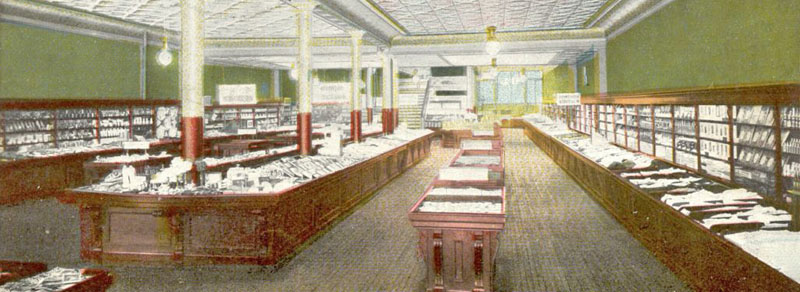
Interior of Woolworth Store in Scranton, Pennsylvania.
By the end of 1904, there were 120 stores in 21 states extending westward as far as Colorado. The following year, the company was incorporated as F.W. Woolworth & Co. to serve Great Britain and Ireland.
As Frank approached his 60th birthday, he started to think about his legacy and determined to build New York City’s tallest skyscraper. He started buying up properties in 1910 and began to build. He bankrolled the $13 million project from his own pocket.
In the meantime, Woolworth merged with four American retail chains to form a single national corporation in November 1911. These retailers were Seymour Horace Knox (Woolworth’s first cousin), with 108 5¢ & 10¢ stores; Fred Morgan Kirby, with 84; Charles Sumner Woolworth (Frank’s brother), with 14; and Earle Perry Charlton, with 48. At that time, Frank had 319 stores, making the total stores after the deal was signed 596 stores coast to coast in 1912.
Work was completed on the Woolworth building in 1913, and the company’s headquarters were moved. It was the tallest skyscraper in the world at the time and remained so until 1930.
In 1917, Woolworth opened its thousandth store in palatial premises on New York’s Fifth Avenue. The same year, President Woodrow Wilson invited Frank Woolworth to take a Government role to raise funds after America joined World War I. Frank complied by launching a savings stamp scheme just weeks later, persuading rival dimestores to join him in selling them. He later funded victory parades for returning servicemen from his pocket in many towns served by a Woolworth Five and Ten.
The final years of Frank Woolworth’s life were filled with sadness. His wife, Jennie, fell ill with early-onset Alzheimer’s. His eldest daughter, Edna, died in May 1917 of an ear infection at the age of 33. However, rumor persisted that she committed suicide by poison in despair over her husband’s philandering, especially as the coroner decided that no autopsy was necessary. Her daughter, Barbara, later dubbed the “poor little rich girl,” made the gruesome discovery, which was said to have haunted her for the rest of her life.
After 40 years of leading the business, Frank Woolworth died on April 8, 1919, in Glen Cove, New York, due to poor health. As he got older, Woolworth suffered violent mood swings and was often bedridden for weeks on end. He was found dead from septic poisoning due to an untreated tooth infection three days after he left work, complaining of a headache. His death came as a great shock across the retail world. He was 66 and had been preparing for the 40th-anniversary celebrations of his 1,200-strong chain.
Afterward, the company directors wanted Charles Woolworth to become the president, but he declined. However, he took on the new role of Chairman, which allowed him to facilitate debate and ensure that issues were properly confronted and argued by the Board. Company Treasurer Hubert Parson became the new president, and over the next 25 years, Charles would watch as four presidents came and went.
In 1929, in Atlantic City, New Jersey, the founder of Foster Grant eyewear, Sam Foster, sold sunglasses from his counter in Woolworth’s on the city’s famous boardwalk, which became a great hit with the sunbathing public.
By 1929, Woolworth had about 2,250 outlets, and its stores continued to grow in the United States and Britain. In 1932, the company raised its price ceiling to 20 cents and abolished price limits altogether in 1935. By this time, shoppers could no longer go into a store and buy anything for a nickel or a dime. The era of buying with pocket change was over.
The stores eventually incorporated lunch counters that served as general gathering places, a precursor to the modern shopping mall food court.
The Woolworth’s concept was widely copied, and 5¢ & 10¢ stores, also called dimestores, became a 20th-century fixture in American downtowns. They often anchored suburban shopping plazas and shopping malls in the 1950s, 1960s, and 1970s.
On February 1, 1960, the Woolworth’s lunch counter in Greensboro, North Carolina, became the setting of an African American sit-in during the Civil Rights Movement. On that date, four black students from North Carolina Agricultural and Technical State University started the Greensboro sit-ins at the “whites only” lunch counter at the Woolworth’s store. A few minutes before, the men, also known as the A&T Four, had bought toothpaste and other products at the desegregated counter. However, once they sat down at the segregated counter, they were refused service when they asked for a cup of coffee. The store policy forbade service of black men at the “whites only” counter. The men then stayed at the counter until closing to protest the inequality.
This touched off six months of sit-ins and economic boycotts that became a landmark event in the civil rights movement. By February 4, 300 people were protesting and expanding their protest to a nearby Kress store. Students protested in cities across the south, including Nashville, Tennessee; Durham, South Carolina; Jackson, Mississippi; and Lexington, Kentucky. Months went by, and students began to boycott the stores. Then, on Monday, July 25, 1960, Greensboro, North Carolina Store Manager Clarence Harris finally asked three black employees to remove their work uniforms, sit at the counter, and order a meal. This was after he lost nearly $200,000 in sales.
Sit-ins and protests would continue to protest the Jim Crow segregation laws for the next several years until the Civil Rights Act of 1964 was passed into law.
In 1962, several Woolworth’s competitors opened similar discount stores, including the S.S. Kresge Company, which opened Kmart, Dayton’s opened Target, and Sam Walton’s first Walmart store.
In 1963, the Woolworth company purchased the shoe manufacturer and retailer G.R. Kinney Corporation (founded 1894) and the Australian shoe store chain Williams the Shoemen in 1969. In 1982 it sold a controlling interest in its British subsidiary. Over the years, Woolworths also acquired other store chains, including Foot Locker, which proved very successful.
In 1979, on Woolworth’s 100th anniversary, it became the largest department store chain in the world.
Europe’s largest F. W. Woolworth store, in Manchester, England, one of two in the city center, experienced a fire in May 1979. Despite the store being rebuilt even larger and up to the latest fire codes, the negative stories in the press, coupled with the loss of lives, sealed its fate; it finally closed in 1986.
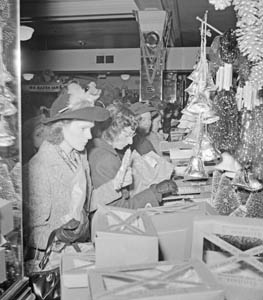
Christmas shopping in Woolworths in Washington, D.C.
By 1982, the company had more than 8,000 stores and was one of the largest retail chains in the world. However, it faced increased competition from the Kmart Corporation and other discount retailers. These pressures compelled Woolworths to rely increasingly on its Foot Locker, Kinney Shoes, and other specialty stores, and its discount stores began to decline.
The growth and expansion of the company contributed to its downfall. The Woolworths Company moved away from its five-and-dime roots and focused less on its department store chain as it focused on its specialty stores. Still, the company could not compete with other chains that had eroded its market share. While it was a success in Canada, the Woolco chain closed in the United States in 1983.
In 1993, an eight-foot section of the lunch counter was moved from the Greensboro, North Carolina store to the Smithsonian Institution. In February 2010, the old Woolworth store was opened as a Civil Rights museum on the 50th anniversary of the beginning of the sit-ins.
On October 15, 1993, Woolworths embarked on a restructuring plan that included closing half its 800-plus general merchandise stores in the United States and converting its Canadian stores to a closeout division named The Bargain! Shop in the hope of gaining profits.
Woolco and Woolworth survived in Canada until 1994 when the majority of the Woolco stores there were sold to Wal-Mart. The Woolco stores that Walmart did not purchase were converted to The Bargain! Shop, sold to Zellers, or shut down.
On January 30, 1997, the company acquired the mail-order catalog athletic retailer Eastbay. On July 17, 1997, Woolworths closed its remaining department stores in the United States and changed its corporate name to Venator in 1998. In 1999, Venator sold and moved out of the Woolworth Building in New York City to offices on 34th Street. The old Woolworth building survives today, continuing to display its grandeur and symmetry.
By 2001, the company focused exclusively on the sporting goods market, changing its name to the present Foot Locker, Inc., and relaunched the Woolworth brand as an online company.
The Woolworths stores in the United Kingdom continued to operate until 2009. Retail chains using the Woolworths name survive in Austria, Germany, and Mexico.
Even though the company went under in the 1990s, Woolworth’s lunch counters are still alive. One such place is the Woolworth Walk in Asheville, North Carolina. Inside the original F.W. Woolworth building are an Art Gallery, a Crafts Emporium, and a soda fountain with old-time favorites. The original store was established in 1938; in 2001, it was restored to showcase a piece of the past.
Another Woolworth Luncheonette is in Bakersfield, California. The Five & Dime Antique Mall features the last Woolworth lunch counter of its kind. On the ground-floor level of the four-story building, the fully functioning former Woolworth luncheonette counter has 22 counter seats, Formica tables ringing the room, and an open kitchen for griddling burgers and making milkshakes. The menu is simple, with burgers and chili dogs with sides including fries, baked beans, macaroni, and potato salad. The workers, dressed in black and white outfits, also serve milkshakes, root beer floats, and sodas. This is the last Woolworth luncheonette counter in America.
In Greensboro, North Carolina, the original Woolworth’s building has been rehabilitated and turned into the International Civil Rights Center & Museum. It commemorates the A&T Four and their role in launching the sit-in movement that inspired peaceful direct-action demonstrations nationwide. The seats and counter remain in the building in their original footprint, and the museum includes exhibits and videos about the A&T Four and the greater American Civil Rights Movement.

